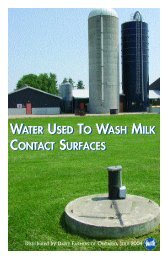Canadian Quality Milk On-Farm Food Safety Program - Centre ...
Canadian Quality Milk On-Farm Food Safety Program - Centre ...
Canadian Quality Milk On-Farm Food Safety Program - Centre ...
Create successful ePaper yourself
Turn your PDF publications into a flip-book with our unique Google optimized e-Paper software.
<strong>Canadian</strong> <strong>Quality</strong> <strong>Milk</strong><br />
original containers. Any drugs dispensed for treatment not in the original container<br />
must be properly identified with the treatment usage, withdrawals and storage<br />
directions, and packaged in a manner that maintains the integrity of the product. A<br />
producer can store medicines and chemicals used on livestock in a manner outside<br />
of label directions ONLY if the producer has a prescription from a veterinarian stating<br />
the different storage conditions.<br />
Store syringes and needles in a clean and sanitary manner and away from livestock<br />
access.<br />
Store livestock medicines away from feeding areas, milk and milking equipment.<br />
All veterinary drugs stored in the milk house or parlour must be kept in a<br />
closed, cleanable storage unit or refrigerator, where appropriate, in a<br />
manner that prevents contamination of milk. Furthermore, pesticides or<br />
toxic chemicals must not be stored in the milk house unless they are<br />
directly related to its operation.<br />
Medicines may be stored temporarily in the parlour if they are intended to be<br />
used during the next milking and the producer can identify which animal is going<br />
to be treated.<br />
Have separate storage areas or facilities for livestock medicines and chemicals<br />
intended for use in non-lactating and lactating dairy cattle and products not intended<br />
for dairy cattle (i.e. for other animals such as chickens and dogs). If all of these types<br />
of products are stored in the same cupboard, they should be at least in separate<br />
sections or shelves and distinctly identified. As a result, a producer may have three<br />
storage areas for medicines: 1) lactating cattle; 2) dry cattle and young stock; and 3)<br />
beef cattle, sheep and other species of animals.<br />
Pesticides labelled for cattle can be stored in the same area as livestock medicines<br />
but they must be separated from and stored below livestock medicines to reduce the<br />
risk of contaminating livestock medicines should the pesticides leak or spill.<br />
Pesticides, cleaners and other substances that are not for use on or in cattle must<br />
not be stored with livestock medicines and chemicals. They must be stored<br />
separately (e.g. another cupboard or different shelves).<br />
Expired products must be disposed of properly or stored separately from nonexpired<br />
drugs to ensure that expired products are not inadvertently used to treat an<br />
animal.<br />
Check the expiry date on all livestock medicines before<br />
purchase.<br />
Purchase enough products for use in a timely manner only.<br />
Use product with the closest expiry date first.<br />
Discard expired products.<br />
Dispose products properly to ensure that cattle cannot<br />
access containers. Some products may have special disposal<br />
requirements.<br />
Transport livestock medicines under the same conditions required for storage.<br />
Keep an up-to-date file of product packages and inserts to allow rechecking of label<br />
Many chemicals used in premilking<br />
preparation and<br />
post-milking sanitation also<br />
have special storage<br />
requirements to maintain<br />
their potency and safety.<br />
These conditions are stated<br />
on the Precaution(s) section<br />
of the label or insert.<br />
4—14<br />
June 2010
















